Page 381 of 522
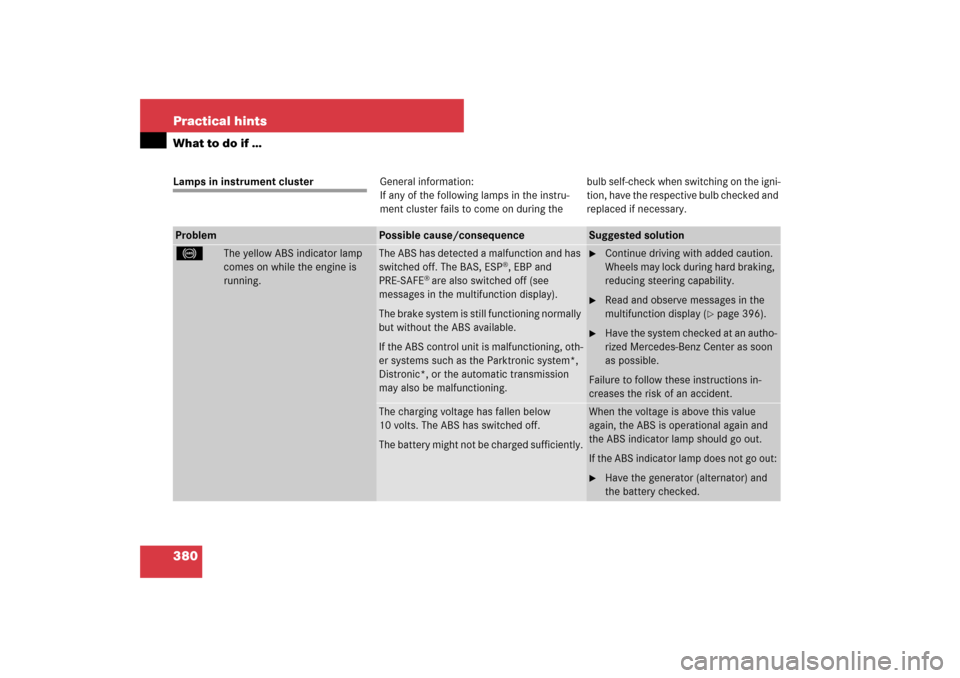
380 Practical hintsWhat to do if …Lamps in instrument clusterGeneral information:
If any of the following lamps in the instru-
ment cluster fails to come on during thebulb self-check when switching on the igni-
tion, have the respective bulb checked and
replaced if necessary.Problem
Possible cause/consequence
Suggested solution
-
The yellow ABS indicator lamp
comes on while the engine is
running.
The ABS has detected a malfunction and has
switched off. The BAS, ESP
®, EBP and
PRE-SAFE
® are also switched off (see
messages in the multifunction display).
The brake system is still functioning normally
but without the ABS available.
If the ABS control unit is malfunctioning, oth-
er systems such as the Parktronic system*,
Distronic*, or the automatic transmission
may also be malfunctioning.
�
Continue driving with added caution.
Wheels may lock during hard braking,
reducing steering capability.
�
Read and observe messages in the
multifunction display (
�page 396).
�
Have the system checked at an autho-
rized Mercedes-Benz Center as soon
as possible.
Failure to follow these instructions in-
creases the risk of an accident.
The charging voltage has fallen below
10 volts. The ABS has switched off.
The battery might not be charged sufficiently.
When the voltage is above this value
again, the ABS is operational again and
the ABS indicator lamp should go out.
If the ABS indicator lamp does not go out:�
Have the generator (alternator) and
the battery checked.
Page 387 of 522
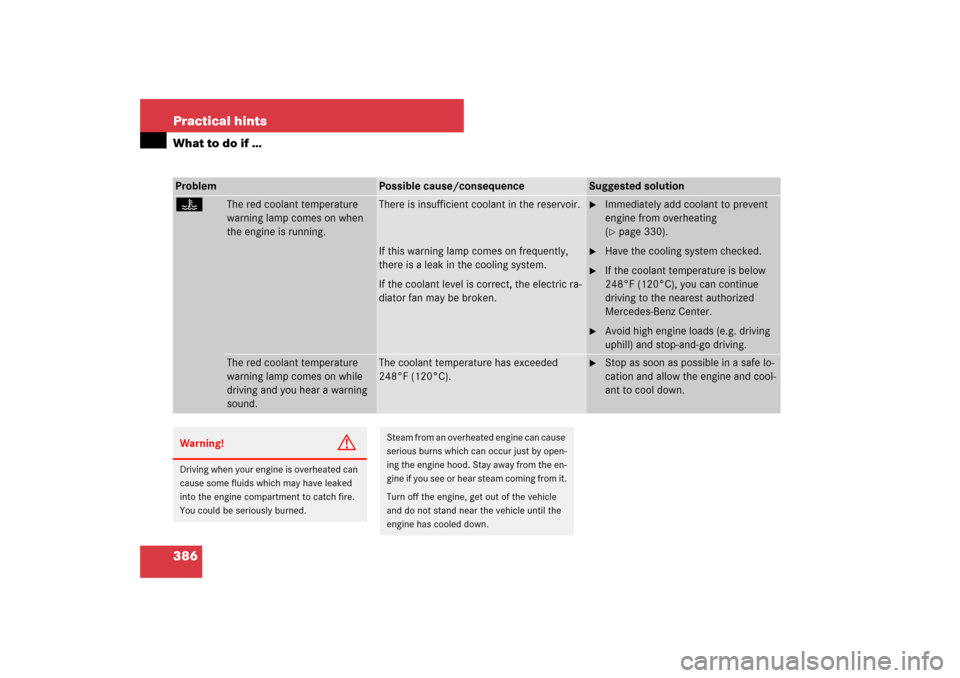
386 Practical hintsWhat to do if …Problem
Possible cause/consequence
Suggested solution
D
The red coolant temperature
warning lamp comes on when
the engine is running.
There is insufficient coolant in the reservoir.
If this warning lamp comes on frequently,
there is a leak in the cooling system.
If the coolant level is correct, the electric ra-
diator fan may be broken.
�
Immediately add coolant to prevent
engine from overheating
(�page 330).
�
Have the cooling system checked.
�
If the coolant temperature is below
248°F (120°C), you can continue
driving to the nearest authorized
Mercedes-Benz Center.
�
Avoid high engine loads (e.g. driving
uphill) and stop-and-go driving.
The red coolant temperature
warning lamp comes on while
driving and you hear a warning
sound.
The coolant temperature has exceeded
248°F (120°C).
�
Stop as soon as possible in a safe lo-
cation and allow the engine and cool-
ant to cool down.
Warning!
G
Driving when your engine is overheated can
cause some fluids which may have leaked
into the engine compartment to catch fire.
You could be seriously burned.
Steam from an overheated engine can cause
serious burns which can occur just by open-
ing the engine hood. Stay away from the en-
gine if you see or hear steam coming from it.
Turn off the engine, get out of the vehicle
and do not stand near the vehicle until the
engine has cooled down.
Page 393 of 522
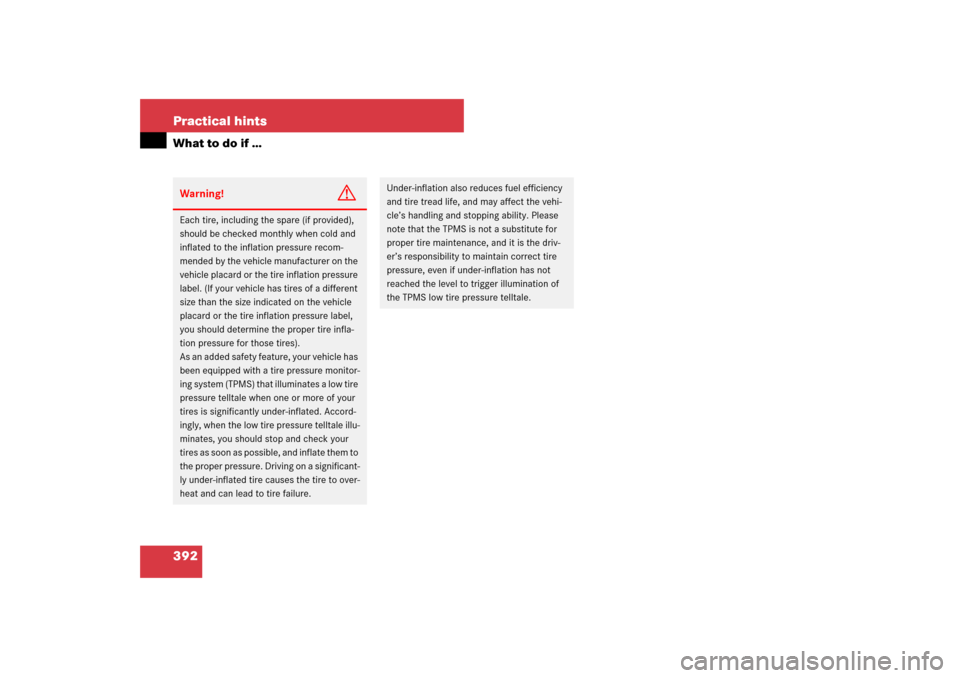
392 Practical hintsWhat to do if …Warning!
G
Each tire, including the spare (if provided),
should be checked monthly when cold and
inflated to the inflation pressure recom-
mended by the vehicle manufacturer on the
vehicle placard or the tire inflation pressure
label. (If your vehicle has tires of a different
size than the size indicated on the vehicle
placard or the tire inflation pressure label,
you should determine the proper tire infla-
tion pressure for those tires).
As an added safety feature, your vehicle has
been equipped with a tire pressure monitor-
ing system (TPMS) that illuminates a low tire
pressure telltale when one or more of your
tires is significantly under-inflated. Accord-
ingly, when the low tire pressure telltale illu-
minates, you should stop and check your
tires as soon as possible, and inflate them to
the proper pressure. Driving on a significant-
ly under-inflated tire causes the tire to over-
heat and can lead to tire failure.
Under-inflation also reduces fuel efficiency
and tire tread life, and may affect the vehi-
cle’s handling and stopping ability. Please
note that the TPMS is not a substitute for
proper tire maintenance, and it is the driv-
er’s responsibility to maintain correct tire
pressure, even if under-inflation has not
reached the level to trigger illumination of
the TPMS low tire pressure telltale.
Page 399 of 522

398 Practical hintsWhat to do if …Text messagesDisplay message
Possible cause/consequence
Possible solution
ABS
ABS, ESP
inoperative
See Operator’s Man.
ABS, ESP
® as well as PRE-SAFE
®
have switched off due to a malfunc-
tion.
BAS is also switched off.
The brake system is still functioning
normally but without the ABS, BAS,
ESP
® and PRE-SAFE
® available.
�
Continue driving with added caution.
Wheels will lock during hard braking, reduc-
ing steering capability.
�
Have the system checked at an authorized
Mercedes-Benz Center as soon as possible.
Failure to follow these instructions increases
the risk of an accident.
ABS, ESP
unavailable
See Operator’s Man.
ABS, ESP
® as well as PRE-SAFE
®
were deactivated because of insuffi-
cient power supply. The charging
voltage has fallen below 10 volts.
The brake system still functions nor-
mally but without the ABS, BAS,
ESP
® and PRE-SAFE
® available.
When the voltage is above this value again, the
ABS, ESP
® and PRE-SAFE
® are operational
again and the message should disappear.
If the message does not disappear:
�
Have the system checked at an authorized
Mercedes-Benz Center as soon as possible.
Page 403 of 522
402 Practical hintsWhat to do if …Display message
Possible cause/consequence
Possible solution
ESP
inoperative
See Operator’s Man.
The ESP
® as well as BAS and
PRE-SAFE® have detected a mal-
function and switched off.
The ABS may not be operational.
The brake system is still functioning
normally but without the ABS, BAS,
ESP
® and PRE-SAFE
® available.
�
Continue driving with added caution.
�
Have the system checked at an authorized
Mercedes-Benz Center as soon as possible.
Failure to follow these instructions increases
the risk of an accident.
Page 404 of 522
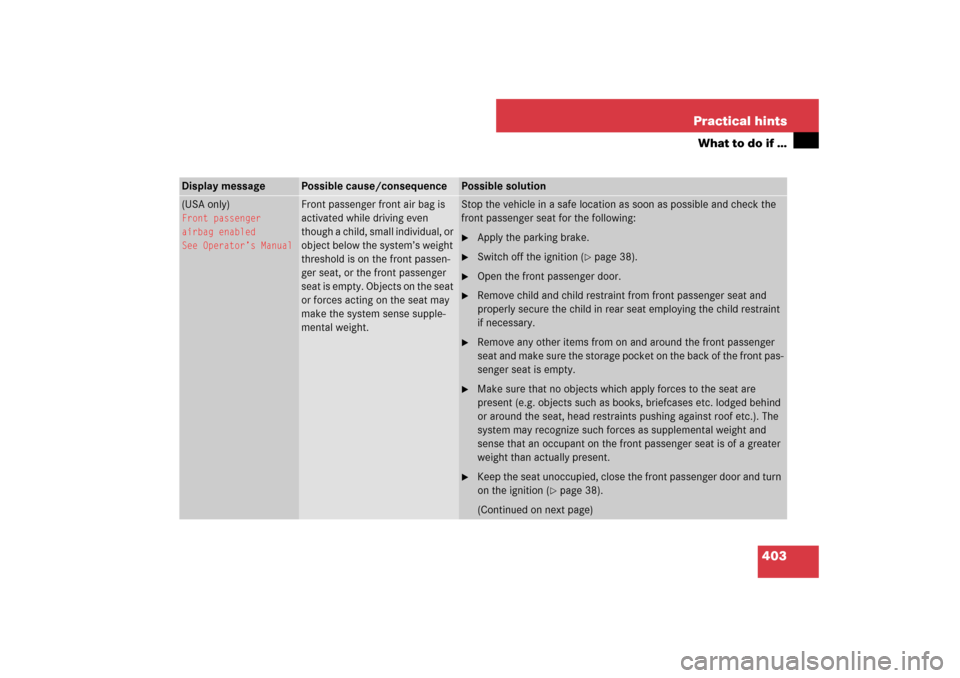
403 Practical hints
What to do if …
Display message
Possible cause/consequence
Possible solution
(USA only)Front passenger
airbag enabled
See Operator’s Manual
Front passenger front air bag is
activated while driving even
though a child, small individual, or
object below the system’s weight
threshold is on the front passen-
ger seat, or the front passenger
seat is empty. Objects on the seat
or forces acting on the seat may
make the system sense supple-
mental weight.
Stop the vehicle in a safe location as soon as possible and check the
front passenger seat for the following:�
Apply the parking brake.
�
Switch off the ignition (
�page 38).
�
Open the front passenger door.
�
Remove child and child restraint from front passenger seat and
properly secure the child in rear seat employing the child restraint
if necessary.
�
Remove any other items from on and around the front passenger
seat and make sure the storage pocket on the back of the front pas-
senger seat is empty.
�
Make sure that no objects which apply forces to the seat are
present (e.g. objects such as books, briefcases etc. lodged behind
or around the seat, head restraints pushing against roof etc.). The
system may recognize such forces as supplemental weight and
sense that an occupant on the front passenger seat is of a greater
weight than actually present.
�
Keep the seat unoccupied, close the front passenger door and turn
on the ignition (
�page 38).
(Continued on next page)
Page 406 of 522
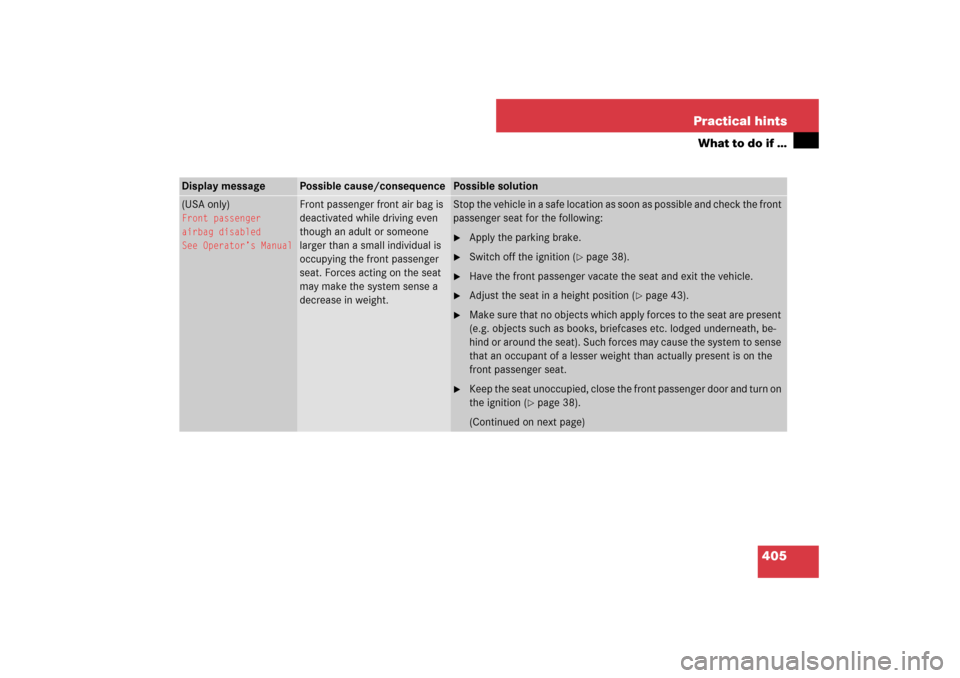
405 Practical hints
What to do if …
Display message
Possible cause/consequence
Possible solution
(USA only)Front passenger
airbag disabled
See Operator’s Manual
Front passenger front air bag is
deactivated while driving even
though an adult or someone
larger than a small individual is
occupying the front passenger
seat. Forces acting on the seat
may make the system sense a
decrease in weight.
Stop the vehicle in a safe location as soon as possible and check the front
passenger seat for the following:�
Apply the parking brake.
�
Switch off the ignition (
�page 38).
�
Have the front passenger vacate the seat and exit the vehicle.
�
Adjust the seat in a height position (
�page 43).
�
Make sure that no objects which apply forces to the seat are present
(e.g. objects such as books, briefcases etc. lodged underneath, be-
hind or around the seat). Such forces may cause the system to sense
that an occupant of a lesser weight than actually present is on the
front passenger seat.
�
Keep the seat unoccupied, close the front passenger door and turn on
the ignition (
�page 38).
(Continued on next page)
Page 408 of 522

407 Practical hints
What to do if …
Display
Possible cause/consequence
Possible solution
P
Gear selector lever
in Park position
You have tried to start the engine with the
KEYLESS-GO* start/stop button with the
gear selector lever not in positionP.
�
Place the gear selector lever in
positionP.
You have tried to turn off the engine with the
KEYLESS-GO* start/stop button with the
gear selector lever not in positionP.
P/N
Shift gear select. lever
to Neutral or Park
You have tried to start the engine with the
KEYLESS-GO* start/stop button while the
gear selector lever was in positionR orD.
�
Place the gear selector lever in positionP
orN. Make sure the brake pedal is de-
pressed.
PRE-SAFE
inoperative
See Operator’s Man.
PRE-SAFE
® itself has failed. All other occu-
pant safety systems, such as the air bags, are
still available.
�
Visit an authorized Mercedes-Benz Cen-
ter as soon as possible.
If ESP
® and PRE-SAFE
® malfunction messag-
es are displayed simultaneously, PRE-SAFE
®
has been deactivated as a result of these
malfunctions. All other occupant safety sys-
tems, such as the air bags, are still available.